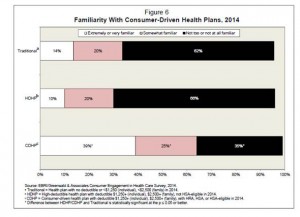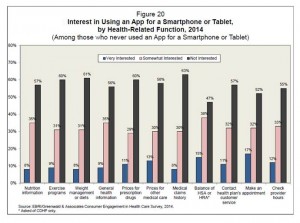 People with more financial skin in the health care game are more likely to act more cost-consciously, according to the latest Employee Benefits Research Institute (EBRI) poll on health engagement, Findings from the 2014 EBRI/Greenwald & Associates Consumer Engagement in Health Care Survey published in December 2014.
People with more financial skin in the health care game are more likely to act more cost-consciously, according to the latest Employee Benefits Research Institute (EBRI) poll on health engagement, Findings from the 2014 EBRI/Greenwald & Associates Consumer Engagement in Health Care Survey published in December 2014.
Health benefit consultants introduced consumer-directed health plans, assuming that health plan members would instantly morph in to health care consumers, seeking out information about health services and self-advocating for right-priced and right-sized health services. However, this wasn’t the case in the early era of CDHPs. Information about the cost and quality of health care services was scant, and people didn’t have the level of health plan literacy required to navigate the new world of (ironically named) ‘consumer-driven’ plans.
As people mature in CDHPs, they become more familiar with the plans’ features and logistics, shown in the first chart. Two-thirds of CDHP enrollees feel they are familiar with the plan, compared with only 34% of people enrolled in traditional health plans (those without any deductible, a shrinking population). Most people in CDHPs undertake cost-conscious decision making in the forms of:
- Checking whether their plan covers care, among 55% of CDHP enrollees
- Asking for generic drugs instead of brand name Rx’s, for 44% of CDHP enrollees
- Talking with doctors about prescription options and costs, 38%
- Checking the price of a health service before getting care, 37%
- Asking a doctor to recommend a less expensive prescription drug, 35%
- Talking with the doctor about treatment options and costs, 34%
- Developing a budget to manage health care expenses, 23%
- Using an online cost tracking tool provided by a health plan, 20%.
Fewer people enrolled in traditional health plan take these actions, across-the-board. The most common types of cost information CDHP members seek are for prescription drugs, office visits, dental care, lab or radiology, outpatient procedures, and vision care.
Enrollees in consumer-directed health plans also tend to be more health-engaged, EBRI found, with more people taking advantage of wellness programs like health risk assessments and health promotion programs. More people in CDHPs also tend to use mobile health apps than people with traditional health insurance plans.
This survey was conducted online in August 2014.
Health Populi’s Hot Points: A decade after first seeing CDHPs in the health insurance marketplace, the times have changed, and health plan consumers are evolving — largely based on their general evolution into the species homo informaticus — information-seeking and digitally-savvy humans — who are embracing transparency in their retail lives. High-deductible health plans mean that “real money” is at-stake — first dollar payment for health services that can add up to much larger out-of-pocket payments than a $20 co-pay for a generic drug or a $100 share in a visit to the emergency department at the closest hospital in your neighborhood.
 Now consumers can find cheap or even free generic drugs at supermarket pharmacies, and $40 visits to a doctor in a suburban Walmart store. In addition, as the survey found, people have begun to go beyond pure information search via search engines online to using mobile platforms to access not only health information, but to track their exercise, weight, and engage with administration for their health care — such as making appointments online, a growing self-service offered by health care providers in the increasingly retail-facing health care environment.
Now consumers can find cheap or even free generic drugs at supermarket pharmacies, and $40 visits to a doctor in a suburban Walmart store. In addition, as the survey found, people have begun to go beyond pure information search via search engines online to using mobile platforms to access not only health information, but to track their exercise, weight, and engage with administration for their health care — such as making appointments online, a growing self-service offered by health care providers in the increasingly retail-facing health care environment.
Looking ahead, it’s intriguing to see that over one-third of people who don’t yet use an app for a smartphone or tablet would be keen to do so for particular health applications: these include accessing nutrition information, exercise programs, weight management and diets, general health information, prices for prescription drugs and health services, medical claims history, checking balances of health savings accounts, and other self-service options for DIY’ing health and health care.
PwC’s 2015 forecast for health care includes DIY health as a key trend, covered in Self-Care is the New Black here in Health Populi and 24×7 at our sister site at HealthcareDIY.




 Thanks to Feedspot for naming this blog, Health Populi, as a
Thanks to Feedspot for naming this blog, Health Populi, as a